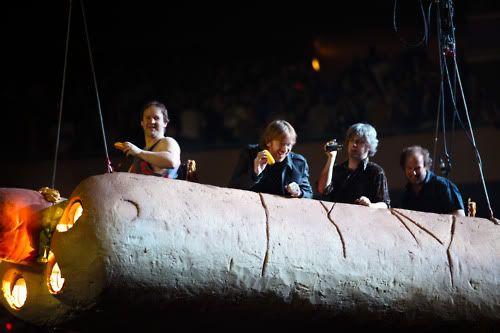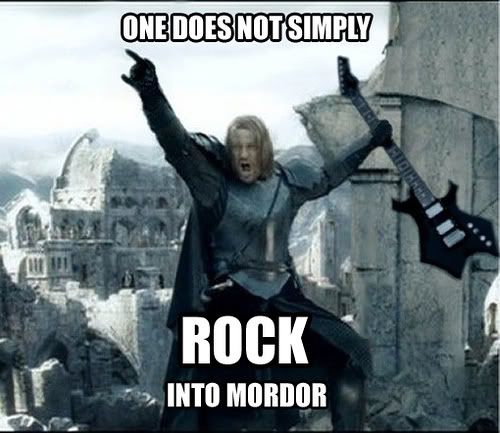
I recently wrote that Tom Doak’s rise to prominence as one of the two greatest living golf architects most closely resembles the career arc of a band that’s a shoo-in for the Rock and Roll Hall of Fame, Phish. Like Phish, Doak conquered the World, and did it his way showing everyone that all the mainstream artistic concepts and business models they had merely accepted as “the way things are done,” were in fact banal, and that there was a better way. He rejected convention, and through incendiary talent came to dominate the landscape. Like Phish, his fans started as a small cloistered group, but also like Phish, they grew stronger and larger through communication over the Internet, which was integral in spreading the word. (Both their fans can even get a little obsessive at times.) Phish is the most Internet-savvy rock band, Doak is the most Internet-savvy golf architect. Like Phish, Doak belongs in his corresponding Hall of Fame.

They both also have a bit of a dorky intellectual streak in them as well that is an indelible part of their idiom. I still don’t know what the Hell Doak means when he says, “solving the problem of proportionality is at the heart of golf course architecture…”
So it got me to thinking – which other golf architects are like rock musicians?
THE TIMELESS GREATS
The Beatles – Alister Mackenzie. Like Beatles music, his courses are the height of artistic achievement, yet they also enjoy unwavering, undying mainstream success. Both are immortal. The Beatles may not be your favorite band, but you like the Beatles. There’s nothing objectionable about their music at all, and if you ever met someone who said, “I hate the Beatles,” you’d instantly assume they were one of Kurt Vonnegut’s space aliens from Tralfalmadore and xenophobically bash their brains in with a 4-iron like that guy did in Breakfast of Champions.
We love Beatles music because of its undeniable purity and perfection. That’s its indelible legacy and contribution to world culture. The same is true of Augusta National and Cypress Point. After all, have you ever met anyone that says they don’t like Alister Mackenzie courses?
***Did you know?*** – Paul McCartney once said that “Maybe I’m Amazed” was only song that he wrote post-Beatles that was good enough for him to record and perform with the Beatles. “I don’t think anything else I did was good enough.” Tough crowd!
Led Zeppelin – A. W. Tillinghast. Remember “Fast Times at Ridgemont High?” When Spiccoli tells a loser fiend of his to make sure he’s playing Led Zeppelin when he picks up the hot chick for a date? Meanwhile the hot chick’s friend tells her to run in the other direction if he says he likes Led Zepp. Sure enough…
Led Zeppelin is, generally, hard stuff. Jimmy Page’s guitar shreds and moans, and screams, but rarely speaks to you. Plant’s voice is a high piercing tenor that shrieks like a Nazgul. Their songs get right in your face. Where the Beatles embrace you, Led Zeppelin pushes you around. You fear Led Zepp’s raw power and respect it because of that fear…but I dare you to dance to it. (For goodness sake, they’re singing about meeting a girl in Mordor. I’m sorry, but Boromir was right, while one does not simply walk into Mordor, one also does not simply rock into Mordor either, no matter what Jimmy Page, “Ramble On,” or “Misty Mountain Hop” may say.) In short, generally speaking, guys dig Led Zepp, girls mostly tolerate it. They’re a man-sized band.

Cut to Tilly and there he is building us a “man-sized course.” His best known and most celebrated designs are the hard major championship venues. Playing those Tilly courses is like listening to Zepp. They’re unquestionably Great (Capital G). You kind of like them (and most other people do too) you have to respect them and do so un-begrudgingly, but you can get weary of how many demands they make on you. Also like Led Zepp, the softer, lilting works go largely un-noticed.
Dire Straits – Donald Ross. It’s sweet, sweet music, a body of work astounding in both its prolixity and consistent excellence. Like every Dire Straits song gives you that electrifying combination of falling hopelessly, faithfully in true love and mysterious sexual desire, so too do you fall quietly in love with nearly every symphonic masterpiece of a Donald Ross course, and get excited by the experience. Broad in their artistic sweep, yet deep in their exploration, and almost universal in their acclaim, everyone likes them – both Knopfler and Ross. They both dressed badly too.

Pink Floyd – Pete Dye. Pink Floyd has the same monumental legacy as Led Zeppelin, but their music is slightly more accessible to a broader demographic. It’s progressive rock that enjoyed near-universal mainstream popularity, something Yes, Phish, Rush, and Genesis could never do. (Well Genesis became mainstream, but only after Peter Gabriel got thrown out of the band for the dumbest of reasons (jealousy) and Phil Collins turned into his generation’s Buster Poindexter. Read: sellout. “Illegal Alien” will go down in history as one of pop music’s worst songs, along with “Poker Face” – Christopher Walken and Eric Cartman do better versions – and Queen’s “Radio Ga-ga.” )
For goodness sake, Dark Side of the Moon stayed on the Top 40 album charts in the U.K. for a staggering 14 years! Even Thriller, the U.S.’s longest-running album only charted for just over a year. And The Wall is still the greatest rock opera ever written, edging out both Tommy and Quadrophenia for the honor. They also were – some say still are – the greatest light show ever devised. They once sent all England into panic, filling the skies with balloons of flying pigs when they released Animals.

When it comes to world domination by a band, Floyd may trail only the Beatles and the Rolling Stones, and while the Stones may have been a bigger cultural phenomenon, Floyd’s music is deeper and far more explorative.
Floyd’s prog rock roots are firmly rooted in classical music (as much of prog rock is) and Dye’s design concepts are firmly rooted in his study of classical architecture from the U.K. Early in his career, Dye knew that to carve out a niche in the golf design business, he’d have to go directly opposite to what everyone was doing (everyone being Robert Trent Jones), just as Floyd consciously moved away from the Rolling Stones. Where Floyd is the “anti-Stones,” Dye is the “anti-Jones.” Floyd conquered the World with Dark Side and The Wall, Dye with Sawgrass, Harbour Town, and Kiawah.
Pete Dye is huge like Floyd is huge, and the world reacts to him the same way. They love him, they respect him, they accept his iconicity, they think he’s a little weird and a little impenetrable at times, (unapologetically so) but he’s still regarded as the highest modern standard of the craft of his generation: like Floyd remarkable in his originality, indeed singularity. You know a Dye course when you see it, they are unmistakable. Sure, somebody out there hates Floyd, but they can’t deny them. The same is true of Dye.
And I’ll bet you a dollar that if you showed Dye a picture of the band, he’d ask, “And by the way, which one’s Pink?”
Speaking of the Rolling Stones…
The Rolling Stones – C.B. Macdonald, Seth Raynor, and Charles “Steamshovel” Banks – The Stones were so much more than just a band or even a phenomenon, they were a cultural upheaval. They commanded the World’s attention, then they turned the World upside down.
“With the Stones being a psycho-sexual movement, parents would look at pictures of the band, see the albums in their kids’ rooms and think ‘My God, what can we expect next from the Stones?'” wrote one pundit, and back in 1971, that was true. Then the Stones came out with Exile on Main Street, unquestionably their greatest, yet most commercially un-heralded album.
Go ahead! Ask your friends: “Do you like the Rolling Stones?” If they say yes, then ask them to name one song off Exile. I’ll give you 1-in-5 odds for $5 per try, and you’ll be my ATM machine until you cry “Uncle.”
The Stones, like the Beatles, were a movement in and of themselves. The architectural legacy of Macdonald-Raynor-Banks, what I call “the Bloodline” for short, is the same. C.B. Macdonald saw that golf architecture was in a doldrums and loudly proclaimed he would do something about it.
He even went about it like a rock star: loudly, proudly, aggressively, and unapologetically. Each course in the Bloodline, though all similar in concept, is flawless in execution. They could take the worst piece of property – something dead flat and uninteresting like Parsippany’s Knoll Club (West) or Country Club of Charleston – and turn it into a strategic masterpiece. And when they got a wonderful plot like Fisher’s Island or National Golf Links of America, or Sleepy Hollow, they built something worthy of the great Renaissance artists. Brilliant in simplicity, yet far reaching in scope, and immortal in legacy, that’s the Bloodline.
Now a new generation of architects is bringing the work of the Bloodline to the forefront. No longer just an obscure name from the mists of time known only by private club members, a host of modern designers are building public facilities and resorts based on the same design tenets and the golf media is beginning to get the word out. The Second Golden Age of Golf Course Architecture has begun, and the golf world is far better for it.
Billy Joel – Devereux Emmet. Chuck Klosterman made an astute observation about Joel – what he did was more important than who he was. Joel was the un-rock star in an era full of bad clothes, too much synth, Euro-pop, and disco. Why do you think the quintessential comparison for “ugly guy-hot girl” is still Christy Brinkley-Billy Joel? His music’s down home simplicity speaks to you in world dominated by so much commercialism. He’s not an archetypal persona, but his creations were archetypal music. While everyone else was blasting away, he wrote “Piano Man” and “For the Longest Time,” and both college kids and their parents listened together while arguing over Frank Sinatra and Beastie Boys.
Emmet’s courses are the same way. Get your ass kicked at a tough Tilly or your sensory overload from Nicklaus or Fazio, then go play an Emmet. You’ll love its Old School earthiness like you love fireworks and flags on the Fourth of July, or warm fruit pies cooling on the windowsill of a wooden Main Street home in a small town, or playing with your child as he/she laughs delightedly and runs into your arms, or getting caught in the rain with your girl and kissing her passionately on the street corner while getting drenched.
As for those architects whose careers are defined by the concept that “who they are” is more important than “what they do…”
Madonna – Tom Fazio. I never had much respect for Madonna. I don’t buy all that nonsense that she’s the voice of a generation and rebelling what the entertainment industry calls vapid middle-class values. I just think much of her career she’s spent trying to get back at her father for naming her “Esther.” She doesn’t speak to me (or for me, for that matter). Like Mr. Blue in Reservoir Dogs, when she got off on that “Papa Don’t Preach” phase, I tuned out, as did most males. And I think you’re retarded if you spend $70 on a Madonna t-shirt, $90 for the one of her gyrating around a stripper pole. “Sticky and Sweet?” More like stale and stuck-up. And for someone who injects sex into everything, she’s the least sexy and most vapid celebrity I know except for Yoko Ono. Most of the time what passes for avant garde is just as much of a commercial as anything else.
Like Madonna, some of Fazio’s early work was impressive, but also like Madonna when he started believing his own press clippings, that’s when things flat-lined. Like Madonna, he’s still in high demand due to the mega-hits over his long career, but much of the industry has moved in a different direction. Even so, there are still people out there determined to live in the 1980s, and they’ll retread anything, whether or not it’s little more than a nostalgia act. In the same vein…
Britney Spears – Jack Nicklaus. It’s all about who he is, not what he does.
Lady Gaga – Desmond Muirhead. Hey Des, Lady Gaga called. She wants to license the rights to that stupid green complex in the shape of a shark’s mouth and turn it into a dress. She’ll give you 7.5%.

KISS – Rees Jones. The glitzy window dressing disguises a mezza-mezza product…Yeah, you wanna rock n roll all night, but after that? It’s all hairspray, ads touting “that championship season,” grease paint, flat greens, patent leather boots, ice rink-smooth fairways (Heaven forbid someone gets an uneven lie), giant tongues spitting fake blood, water tee-to-green, chest hair, inkblot bunkers with a grillion noses, pyrotechnics, 7,600 yards, stupid songs like “Ladies Room,” and “Calling Dr. Love,” and people screaming bloody murder that he turned Torrey Pines to Snorey Pines and Cog Hill to Slog Hill.
Now there are three reactions to this.

1) The glass is 2/3 empty. As you look back on it, you wonder how you could have liked it in the first place and make a point of hiding your past affinity for it. Bethpage, Old Kinderhook, and “Shout it Out Loud”…anything else?
2) The glass is 1/3 full. You don’t take it as seriously as KISS/Rees does, and just go for the nostalgia act aspect of it. Live a little, and have a good time. The resurrection of Bethpage is a golf miracle and that movie where KISS battles the phantom of the amusement park is funny in a campy sort of way. So Torrey and Cog Hill are harder? Are they any worse? In the case of Torrey, no, in the case of Cog Hill, that remains to be seen.
3) The glass is completely full. Celebrities make you starry-eyed and all gooey inside, so you’ll believe everything someone famous throws your way, even Family Jewels and Talamore. ***Makes “rock hands” by sticking fore-and little fingers in air while holding other fingers with thumb and shouts “Hazeltine, Dude!”***
Rush – Bob Cupp/Tom Kite. From Webster’s Hip Dictionary, 2011 Edition – nimrod (NIHM-rahd – noun, slang) a loser who spends weekends with no date playing video games in mom’s basement in his underwear surrounded by empty Shasta bottles and all-Rush mix tapes. (You can say the same about fans of They Might Be Giants. Dork alert!!)
THE MINIMALIST MOVEMENT
The Minimalist Movement is golf architecture’s rejoinder to punk rock. Punk rock is all about just “plug in and go” – no foot pedals, no effects, no synthesized music, no syrupy-sweet mixing. It’s raw emotion in its most natural, unprocessed form.
Now punk rock has evolved over the decades so that there are many roots and branches that represent the countless different forms of individual expressions of universal truths. There’s hardcore, nerdcore, hobo-core, pop-punk, speed-pop-punk, bubble gum punk, post-pop laptop punk, rap punk (yes, rap punk!) funk-punk, grunge punk, post-grunge, old school, new school, and many others. The journey from The Ramones to MC Lars is fascinating, but for our purposes that must take a back seat to the comparisons. When a punk band takes the stage (except a post-pop laptop act) it’s them, their instruments, their amps, and their beers. Here’s one of my favorite stories on that score:
As part of my law practice, I represent a lot of musical instrument manufacturing companies and get musicians various deals for gear. This scene describes the punk movement perfectly:
Jay to Bowling for Soup – “Hey! You guys want me to get you a deal for effects pedals?”
BFS – “Jay, we don’t use effects pedals…”
***Cricket! Cricket! Cricket!***
Minimalism is also about rejecting conformity and convention. When kids decorated their Deerfield Academy dorm rooms with grocery bags with anarchy symbols and Black Flag logos drawn in Sharpie, they knew exactly what they were doing, because those were the guys that graduated a year early and went off to Cal-Berkeley. Well when Coore and Crenshaw just went out and threw down stakes on the most severe parts of the property saying, “tee” and “green,” they may or may not have known they would plant the seeds for a movement in golf architecture that would germinate so powerfully, it would burst the earth asunder at the feet of the establishment and give rise to the Second Golden Age of Golf Architecture, but they sure knew how to build a compelling golf course. What they did was bold, gritty, and undeniably natural – no window dressing, no special effects, no apologies…none necessary! So without any further ado…
Foo Fighters – Coore and Crenshaw. For goodness sake, part of The Colour and the Shape was recorded from scratch to completion in a tumbledown shack on a farm in Woodinville, Washington, while the band slept on the floor of the nearby farmhouse. They had to keep chasing the horses out of the building while recording, and bathed in a salmon stream mere feet from where they’d produce the disc that showcases their defining musical legacy. The same is true of C&C’s approach to building a golf course. Get on the ground and get dirty, and that’s the whole DIY ethos that punk strives to promote. Bill Coore is David Grohl minus the white t-shirt, bad tribal art tatts, and chewing gum. (How do you chew gum and sing at the same time?)
C&C are Foo Fighters because while they’re totally the punk rock ethos of golf course architecture, they’re still tidy around the edges, not overly in your face, and a cleaner in presentation than hardcore punk guys like say Gil Hanse and George Bahto. When you play a C&C you see the minimalism, but it’s not grungy, or intentionally unapologetic in its rough and tumble design. That’s Hanse and Bahto. That’s Tallgrass and Inniscrone, not Chechessee Creek or Sand Hills. C&C groove and body surf, but Hanse and Bahto slam dance. Where C&C are Grohl and Neil Mendel, Hanse and Bahto are the Ramones and Black Flag.
On another note, I’d give anything to see Bill Coore’s face when someone plays him the video of “Monkeywrench” from Everywhere but Home. Whoever you are, please, please, please call me after you do that so I can hear the story. Better yet, Skype Videophone me before you do it…
Bowling for Soup – Kelly Blake Moran/Jeff Brauer. Polished minimalism that’s brilliant in its simplicity, hilarious in its counter-culturalistic rejection of mainstream, and best of all, all-Texas all the time! Throw up your rock hands again and shout “Go Dallas Stars,” or “How ’bout them Cowboys!”

OTHER INTERESTING CATS
Yes meets Jeff Buckley – Mike Strantz. Yes was always an acquired taste, one that, like Rush and old Genesis, made demands on the ear and required a tolerance for long, intricate songs that sometimes made no complete sense to anyone but the band (but you, of course, could interpret it however you wanted). Weird things like “The Gates of Delirium” or anything off Tales from Topographic Oceans, would get mixed in with rocking songs like “Roundabout” or “Going for the One.” It was eclectic, to be sure, but intricate, artistic, and intelligent. They were the proggiest of the prog rock bands that got noticed by the zeitgeist.
Some of Mike Strantz’s golf holes look like they belong on the cover of Yes albums. 11 at Monterey Peninsula Country Club and much of Tobacco Road leap to mind immediately.
“I’ve never seen anything like it,” people always say. It was bold, intelligent, visually arresting, and outstanding golf.
Strantz was also as incendiary a talent as Jeff Buckley. He was great right out of the gate, dominating the landscape even in places formerly unassailable. Caledonia is the best course in Myrtle Beach. Tobacco Road is the only course to give Pinehurst No. 2 a run for its money, and Monterey Peninsula Shore Course fits perfectly between Pebble Beach and Cypress Point. Buckley, you may recall was a SONY artist put on their Legacy label right away, home of some of history’s greatest musicians across any genre or time period.
When asked the secret to his high-energy, emotion-ripping concert performances, Buckley said “It’s like long distance running. Just keep going until you can’t go any further. Then go further, because the moves you make then – when you’ve run out of steam and you’re totally on subconscious and not even thinking about the mechanics – the moves you make then are incredible.”
Buckley was talking about himself, but he was speaking for any true artist, any true trailblazer, any true maverick. Yes, even a golf course architect. Both his body of work and Mike’s are bold examples of what can be accomplished if you think outside the box. Sadly, like Jeff Buckley, we lost Mike to oral cancer far too soon, in the height of his ascension. The golf world mourns the loss of Strantz like it mourns the loss of Buckley – my God, what might have been.
Also like Buckley, we don’t think his work is better simply because he’s dead.
Talking Heads – Jim Engh. He may adore Van Morrison but Engh is golf architecture’s rejoinder to David Byrne, only he’s perfectly sane, drinks Guinness, and could fit in the “Big Suit,” just without the air pumped in it. (Dude is 6 feet and all muscle!)
Jim actually wasn’t all that thrilled when I told him he was Talking Heads. He likes Talking Heads and appreciates their Greatness (again, Big G), but he thought their relatively short career arc was a negative. I disagree. Yes, all of rock music wishes we got more from the band than we did, but what we got was epic. Rolling Stone called Stop Making Sense the greatest concert film in history, and it may well be. The Last Waltz (The Band’s final concert, for those of you scoring at home) is great, but the intermixing of interviews – admittedly excellent and probing – mixing interviews with music takes it slightly out of the realm of a true concert film and interrupts the flow. Everyone danced in the aisles the whole time during screenings of Stop Making Sense. You can’t do that with Last Waltz. Under a Blood Red Sky (U2 in full ascension) is perhaps the only other concert film so electrifying as to be transcendent on such a scale – and by the way, isn’t Red Rocks the greatest concert venue in America?
Talking Heads were unabashedly different in their presentation, yet their music is groovy. (That’s groovy in the musical sense of the word, meaning “has a groove to it” – not groovy in the slang sense of the word, meaning “cool.”) Byrne had big suits, Weymouth had wild outfits, they built the set as the show progressed, they jogged in place, and they burned down the house every night. Phish thinks enough of Talking Heads that they performed Remain in Light as their Halloween album in 1996, and that’s one of rock music’s highest compliments.

Engh does things his way, much like David Byrne. Engh gave us not only one of the newest bunker shapes in history – the muscle bunker with its almost Van Gogh-esque squiggly shape – but also one of the coolest. He builds unseen ways to play golf holes – cool little options called “trap doors” and “hidden stairways,” – yet everything is something he brought over from myriad trips to the U.K., just with a different artistic spin. He’s a refreshing voice. And he caught fire quickly with multiple best new course awards in a few short years. Everyone seems to love his newest instant classic in Nebraska, Awarii Dunes. And he confounds his critics, who are left to howl lunacies at him that amount to nothing more than “Stop Making Sense! Stop Making Sense! Stop Making Sense! Making Sense! Ah Ha!” Excuse me now, while I go crank “Once in a Lifetime” at top volume.
OTHERS
Garth Brooks – Dan Maples. He’s a little bit country, a little bit rock and roll, but he’s the undisputed King of the Carolinas.
Ominous Seapods – Stephen Kay. Obscure but brilliant, the work is sublime. They just needed time. The world needs to hear more about them, and they belong on the biggest stage.
Johnny Cash – Lester George and Mike Young. Big and bold, rompin’ and stompin’, watch out for these two rising stars.




